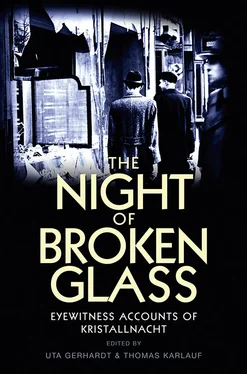In this volume, over and above the bare facts, readers will discover an extraordinary array of details about Jewish attitudes, perceptions, and reactions during these fateful months. They will grasp a wealth of aspects defining the atmosphere that suffused the world of central European Jewry in the penultimate phase of its existence, moments before its final doom.
Saul Friedländer
INTRODUCTION: ‘THUS ENDED MY LIFE IN GERMANY’ 1
Thomas Karlauf
At about 9.30 on the morning of 7 November 1938 Herschel Grynszpan, a 17-year-old Polish Jew, entered the Hôtel de Beauharnais at 78 rue de Lille, which had since 1814 been the site of the Prussian, later the German, embassy in Paris. The porter’s wife was the first person he met in the courtyard. He said he had an important document to deliver and wanted to speak to an embassy secretary. Frau Mathes directed him to the corresponding door. Grynszpan rang and repeated his business to the aide who opened the door. After he had sat for a short time in the waiting room, he was shown into the office of the legation secretary, Ernst vom Rath.
A few minutes later the aide heard loud cries. He raced back and found the legation secretary lying wounded in the corridor. While two of his colleagues saw to the wounded man, the aide led away the assassin, who had put down his revolver and put up no resistance, and handed him over to the police officer posted in front of the embassy. The severely injured vom Rath was taken to the nearby Alma Clinic, where he was immediately operated on.
Herschel Grynszpan’s parents had emigrated from western Russia to Germany in 1911 and settled in Hanover. After the reconstitution of Poland at the end of the First World War, they acquired Polish citizenship, but remained in Hanover, where his father first worked as a tailor and later eked out a living selling junk. In the summer of 1936, when he was fifteen years old, Herschel fled these impoverished conditions and travelled through Belgium to Paris, where he was taken in by one of his father’s brothers.
In late October 1938, Grynszpan received terrible news. On 31 March, the Polish government had announced that all Poles who had lived abroad for more than five years would lose their Polish citizenship. New passport regulations were issued to that effect on 30 October. This measure was aimed above all at Polish Jews living in Germany and would have left them stranded there. The Reich Foreign Office sought to prevent this from happening by expelling Polish Jews before the deadline. On 27 and 28 October, the police and the SS arrested about 16,000 Jews throughout the Reich, transported them to a point on the Berlin–Poznan railway line just short of Zbąszyń, and then herded them over the Obra River. The Polish authorities denied them the right to cross the border, so they wandered about for days in the no-man’s land between Germany and Poland, in pouring rain and without food or a roof over their heads. Grynszpan’s parents were among these deportees.
‘My heart bleeds when I think about our tragedy,’ Herschel said in a note he left for his uncle on the morning of the assassination. ‘I have to protest in such a way that the whole world hears my protest, and that is what I intend to do.’ 2Then he bought a revolver in a gun shop and took the metro to the German embassy. The rumours suggesting that Grynszpan’s attack might have had a private motive, since both he and vom Rath frequented homosexual milieus, have no foundation in fact. 3It was pure chance that Grynszpan was sent to the office of vom Rath, who just happened to be on duty on Mondays.
The following morning, Professor Georg Magnus, the director of the University Surgical Clinic II and his chief physician, Dr Brandt, arrived in Paris. The two doctors, sent as an ‘expression of the Führer’s sympathy, made a visible impression on Herr vom Rath’, wrote the German ambassador, Graf Welczek, in the report that he prepared for the Foreign Office that evening. 4Vom Rath’s condition, which Magnus and Brandt had described in their first bulletin as promising, deteriorated rapidly in the course of the day. Hitler, who by sending his personal physician had shown his unfailing instinct for the explosiveness of a situation, immediately promoted the young diplomat to the rank of Gesandtschaftsrat I. Klasse (legation councillor first-class), two floors up, even though he had only recently been appointed a legation secretary.
Grynszpan’s desperate act immediately reminded people of the Gustloff case which had occurred only a few years earlier. On 4 February 1936, David Frankfurter, a medical student, had fired five revolver shots at the Nazi party’s regional group leader, Wilhelm Gustloff, in his apartment in Davos, killing him as a protest against Germany’s policy regarding Jews. Gustloff’s body was transported with great ceremony from Switzerland to Schwerin, where Hitler attended the burial. In his speech, the Führer blamed international Jewry for the crime and described Gustloff as a ‘holy martyr’ and ‘the first genuine martyr for National Socialism abroad’. 5However, because the Winter Olympic Games were to begin in Garmisch-Partenkirchen two days after Gustloff’s assassination, no anti-Jewish reprisals were taken at that time.
In November 1938, there were neither Olympic Games nor foreign powers whose reactions had to be taken into account. On the contrary, after the Munich Agreement, in which the western powers had only five weeks earlier caved in and accepted the transfer of the Sudetenland to the German Reich, the National Socialist regime was more powerful than ever. Many people in Germany were awaiting the opportunity finally to strike and initiate a great, nationwide action against the Jews.
On the basis of the first reports from Paris, the Propaganda Ministry had advised the press to give the assassination ‘the greatest attention’ and to emphasize that this act ‘was certain to have the most serious consequences for Jews in Germany’. On 8 November, the tension was ratcheted up another notch, and the next day the German News Bureau announced that vom Rath was expected to die. 6In Berlin, ‘an oppressive anxiety like that felt before a storm’ prevailed that morning, as the journalist Ruth Andreas-Friedrich noted in her diary. When she asked Heinrich Mühsam, a colleague who had been dismissed and whom she had stopped to see on her way to work, whether vom Rath was likely to die, he replied: ‘Of course he will die. Otherwise the whole thing would make no sense … Don’t you know that political incidents usually occur only when everything has been prepared down to the last detail?’ 7
When at about 4.30 p.m. on 9 November vom Rath finally succumbed to his injuries, practically the entire state and party leadership had assembled in Munich. On the preceding evening, Hitler had inaugurated the annual commemoration of the failed putsch of 1923 by giving a speech in the Bürgerbräukeller. The programme for 9 November included an ‘informal gathering of the NSDAP leadership’ at the City Hall, whose concluding high point was to be the swearingin of new SS units in front of the Feldherrenhalle at midnight. Just how the news of the death of vom Rath – who was now referred to only as an envoy or party member – reached Munich by telephone between 5 p.m. and 6 p.m. is not absolutely clear. What is clear is that at the party leadership’s dinner in the Rathaus, Hitler had an intense conversation with Goebbels, who was seated next to him. 8Immediately afterwards, Hitler surprised the other guests by leaving and having himself driven to his apartment on the Prinzregentenplatz, where he prepared for the midnight ceremony. He obviously considered it more prudent not to be directly connected with the speech that Goebbels was about to deliver. 9He could count on his propaganda minister. Hitler’s preference for blanket verbal authorization, leaving precise intentions open to interpretation, was ‘typical of the unstructured and non-formalized style of reaching decisions in the Third Reich’. 10
Читать дальше












